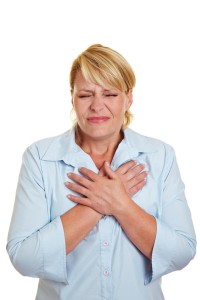Breast pain is also known as mastalgia which is a common problem among women. The affected person can experience tenderness of the breast, sharp burning pain and tightness of the tissue of the breast. The pain can happen occasionally but it can also be constant.
Pain in the breast can be mild to severe and lasts for a few days or months and can also manifest just before the menstruation or last for seven days or more every month. Post-menopausal women can sometimes experience pain in the breast, but it is more common among younger, premenopausal and premenopausal women.
What are the symptoms?
Symptoms of breast pain can be classified as cyclic or non-cyclic.
Cyclic breast pain

- Occurs with the menstrual cycle where there is heavy and dull aching pain
- Swelling of the breast or lumpiness
- Pain usually affects both breast, usually the upper and outer part and can spread to the underarm area
- Usually affects women in their 20s and 30s before menopause and also women in their 40s who are transitioning to their menopausal age.
Non-cyclic breast pain
- Does not occur together with the menstrual cycle
- The pain can be tight, sore or burning
- Pain can be intermittent or constant
- It usually affects one breast and localized in one area but can spread more widely across the breast.
- Women after menopause are more susceptible to this condition.
Causes
- Breast pain can be caused by reproductive hormones. The cyclic breast pain usually becomes minimized or disappears during pregnancy or menopause.
- Non-cyclic breast pain usually occurs due to the structure of the breast such as having cysts in the breast, trauma on the breast and even breast surgery.
- An imbalance of fatty acids found within the cells affects the sensitivity of the tissues of the breast.
- There is neck, shoulder and back pain or discomfort due to large breasts.
Treatment
- Apply alternately warm and cold compresses to the breasts since it helps lessen the pain in the breasts.
- When performing exercises and while sleeping, wear a sports bra especially when the breast is sensitive as well as women with large breasts.
- Eat a low-fat diet and avoid fatty foods such as meat, cheese, full-fat milk, butter and cream. In addition, foods made of pastry must be avoided as well in order to lessen the pain in the breast.
- Eat carbohydrates such as bread, rice, pasta, potatoes as well as varieties of fresh fruits, vegetables and fish.
- Perform some relaxation techniques such as yoga helps in minimizing levels of anxiety that can cause severe pain in the breast.
- Take the prescribed pain medications and vitamins in order to help lessen the pain in the breast such as Tylenol, Advil and Motrin. Take vitamin E supplement at least every day since it also helps in minimizing the pain in the breast.
